壳聚糖相关的所有产品资料
- 格式:doc
- 大小:192.50 KB
- 文档页数:9
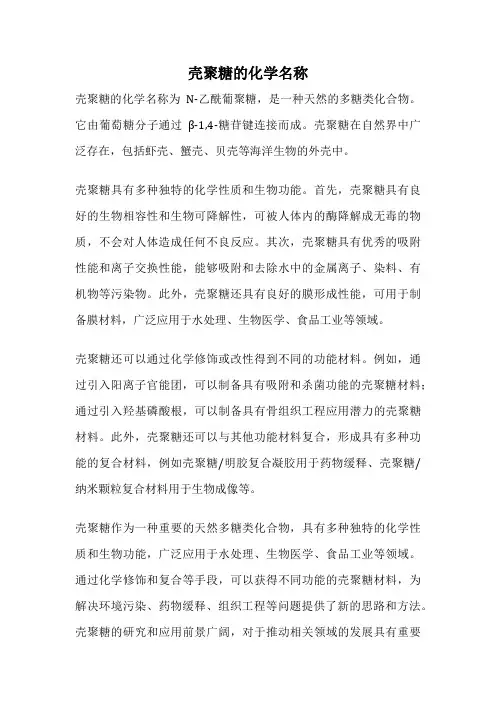
壳聚糖的化学名称
壳聚糖的化学名称为N-乙酰葡聚糖,是一种天然的多糖类化合物。
它由葡萄糖分子通过β-1,4-糖苷键连接而成。
壳聚糖在自然界中广泛存在,包括虾壳、蟹壳、贝壳等海洋生物的外壳中。
壳聚糖具有多种独特的化学性质和生物功能。
首先,壳聚糖具有良好的生物相容性和生物可降解性,可被人体内的酶降解成无毒的物质,不会对人体造成任何不良反应。
其次,壳聚糖具有优秀的吸附性能和离子交换性能,能够吸附和去除水中的金属离子、染料、有机物等污染物。
此外,壳聚糖还具有良好的膜形成性能,可用于制备膜材料,广泛应用于水处理、生物医学、食品工业等领域。
壳聚糖还可以通过化学修饰或改性得到不同的功能材料。
例如,通过引入阳离子官能团,可以制备具有吸附和杀菌功能的壳聚糖材料;通过引入羟基磷酸根,可以制备具有骨组织工程应用潜力的壳聚糖材料。
此外,壳聚糖还可以与其他功能材料复合,形成具有多种功能的复合材料,例如壳聚糖/明胶复合凝胶用于药物缓释、壳聚糖/纳米颗粒复合材料用于生物成像等。
壳聚糖作为一种重要的天然多糖类化合物,具有多种独特的化学性质和生物功能,广泛应用于水处理、生物医学、食品工业等领域。
通过化学修饰和复合等手段,可以获得不同功能的壳聚糖材料,为解决环境污染、药物缓释、组织工程等问题提供了新的思路和方法。
壳聚糖的研究和应用前景广阔,对于推动相关领域的发展具有重要
意义。
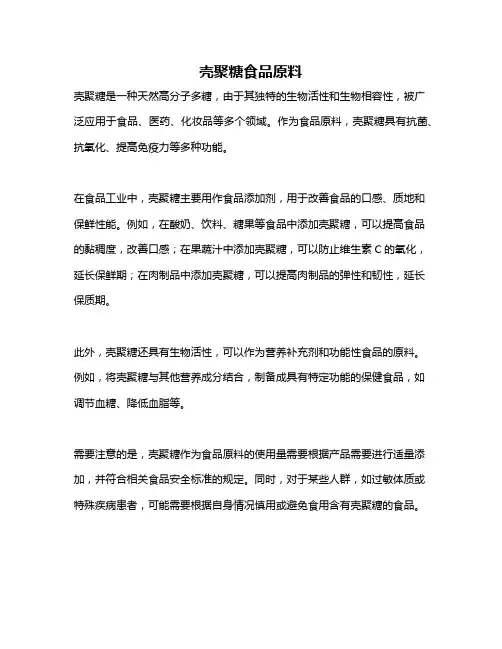
壳聚糖食品原料
壳聚糖是一种天然高分子多糖,由于其独特的生物活性和生物相容性,被广泛应用于食品、医药、化妆品等多个领域。
作为食品原料,壳聚糖具有抗菌、抗氧化、提高免疫力等多种功能。
在食品工业中,壳聚糖主要用作食品添加剂,用于改善食品的口感、质地和保鲜性能。
例如,在酸奶、饮料、糖果等食品中添加壳聚糖,可以提高食品的黏稠度,改善口感;在果蔬汁中添加壳聚糖,可以防止维生素C的氧化,延长保鲜期;在肉制品中添加壳聚糖,可以提高肉制品的弹性和韧性,延长保质期。
此外,壳聚糖还具有生物活性,可以作为营养补充剂和功能性食品的原料。
例如,将壳聚糖与其他营养成分结合,制备成具有特定功能的保健食品,如调节血糖、降低血脂等。
需要注意的是,壳聚糖作为食品原料的使用量需要根据产品需要进行适量添加,并符合相关食品安全标准的规定。
同时,对于某些人群,如过敏体质或特殊疾病患者,可能需要根据自身情况慎用或避免食用含有壳聚糖的食品。
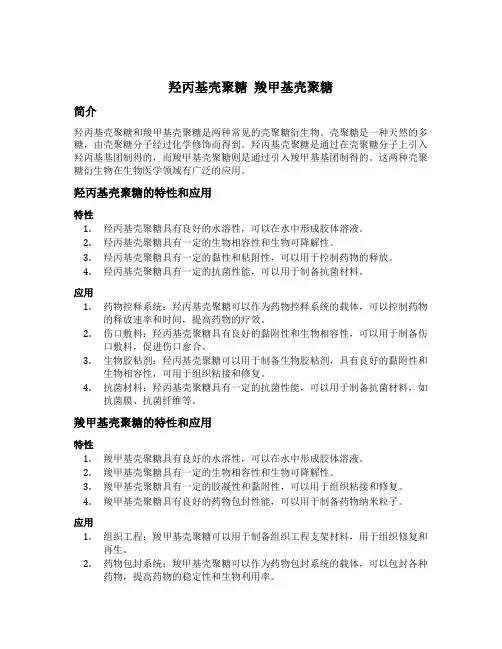
羟丙基壳聚糖羧甲基壳聚糖简介羟丙基壳聚糖和羧甲基壳聚糖是两种常见的壳聚糖衍生物。
壳聚糖是一种天然的多糖,由壳聚糖分子经过化学修饰而得到。
羟丙基壳聚糖是通过在壳聚糖分子上引入羟丙基基团制得的,而羧甲基壳聚糖则是通过引入羧甲基基团制得的。
这两种壳聚糖衍生物在生物医学领域有广泛的应用。
羟丙基壳聚糖的特性和应用特性1.羟丙基壳聚糖具有良好的水溶性,可以在水中形成胶体溶液。
2.羟丙基壳聚糖具有一定的生物相容性和生物可降解性。
3.羟丙基壳聚糖具有一定的黏性和粘附性,可以用于控制药物的释放。
4.羟丙基壳聚糖具有一定的抗菌性能,可以用于制备抗菌材料。
应用1.药物控释系统:羟丙基壳聚糖可以作为药物控释系统的载体,可以控制药物的释放速率和时间,提高药物的疗效。
2.伤口敷料:羟丙基壳聚糖具有良好的黏附性和生物相容性,可以用于制备伤口敷料,促进伤口愈合。
3.生物胶粘剂:羟丙基壳聚糖可以用于制备生物胶粘剂,具有良好的黏附性和生物相容性,可用于组织粘接和修复。
4.抗菌材料:羟丙基壳聚糖具有一定的抗菌性能,可以用于制备抗菌材料,如抗菌膜、抗菌纤维等。
羧甲基壳聚糖的特性和应用特性1.羧甲基壳聚糖具有良好的水溶性,可以在水中形成胶体溶液。
2.羧甲基壳聚糖具有一定的生物相容性和生物可降解性。
3.羧甲基壳聚糖具有一定的胶凝性和黏附性,可以用于组织粘接和修复。
4.羧甲基壳聚糖具有良好的药物包封性能,可以用于制备药物纳米粒子。
应用1.组织工程:羧甲基壳聚糖可以用于制备组织工程支架材料,用于组织修复和再生。
2.药物包封系统:羧甲基壳聚糖可以作为药物包封系统的载体,可以包封各种药物,提高药物的稳定性和生物利用率。
3.生物胶粘剂:羧甲基壳聚糖具有良好的胶凝性和黏附性,可以用于组织粘接和修复,如骨折固定、组织粘合等。
4.药物纳米粒子:羧甲基壳聚糖可以用于制备药物纳米粒子,提高药物的溶解度和生物利用率。
总结羟丙基壳聚糖和羧甲基壳聚糖是两种常见的壳聚糖衍生物,具有良好的水溶性、生物相容性和生物可降解性。
![壳聚糖季铵盐硅凝胶治疗增生性瘢痕的临床观察[权威资料]](https://uimg.taocdn.com/f9a938c0cf2f0066f5335a8102d276a200296092.webp)
壳聚糖季铵盐硅凝胶治疗增生性瘢痕的临床观察本文档格式为WORD,感谢你的阅读。
[摘要]目的:评价壳聚糖季铵盐硅凝胶治疗增生性瘢痕的临床疗效及不良反应。
方法:选择200例增生性瘢痕患者,给予壳聚糖季铵盐硅凝胶和嘉氏堂自制的不含壳聚糖季铵盐的单纯硅凝胶进行治疗,观察1个疗程,通过对治疗前后的皮损颜色、皮损隆起的高度、皮损硬度、瘙痒、触痛这五个方面分别进行评分,综合评定其疗效及安全性。
同时随访患者治疗结束后的副作用,随访至6个月。
结果:壳聚糖季铵盐硅凝胶治疗增生性瘢痕有效率可达100%,单纯硅凝胶有效率为82%,均未发现任何毒副作用。
结论:壳聚糖季铵盐硅凝胶治疗增生性瘢痕疗效显著,且安全无痛苦,值得临床推广应用。
[关键词]壳聚糖季铵盐硅凝胶;增生性瘢痕;临床观察[]R619+.6 []A []1008-6455(2014)21-1810-03Abstract: Objective To evaluate the effect of SQASC in the treatment of hypertrophic scar and its untoward effect. Methods Chose 200 cases of hypertrophic scar patients, and observed the effect throughout one course of SQASC treatment and JiaShiTang's homemade pure silica gel, which didn't not contain quaternary ammonium salt of chitosan,Scores were based on these five aspects of the color of skin lesions, raised height of lesions,the hardness, itching and tenderness before and afterthe treatment. And assessed comprehensively curative effect and safety.Followed up patients for 6 months after the treatment in case of side effect. Results Its effectiveness for treating hyperplastic scar can reach 100%,and JiaShiTang's homemade pure silica gel,which didn't not contain quaternary ammonium salt of chitosan,can reach82%,and have not found any side effects yet. Conlusion SQASC's therapeutic effect in the treatment of hypertrophic scar is significant,safe and painless,and so worthy of clinical application.Key words:SQASC (silicone of quaternary ammonium salt of chitosan);hypertrophic scar;clinical observation增生性瘢痕是皮肤真皮损伤愈合后遗留的高出周围皮肤发红、坚硬的病理组织,不仅影响美观,还可引起严重的功能障碍,甚至残疾,是烧伤整形领域研究的难点和重点之一[1-2],虽然世界各国的学者对瘢痕的组织结构及形成机制进行了有益的探索,但至今仍无满意的防治药物和方法[3]。
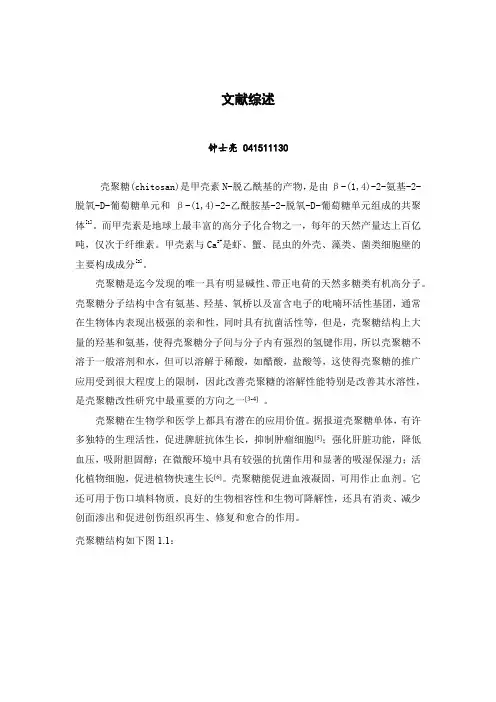
文献综述钟士亮 041511130壳聚糖(chitosan)是甲壳素N-脱乙酰基的产物,是由β-(1,4)-2-氨基-2-脱氧-D-葡萄糖单元和β-(1,4)-2-乙酰胺基-2-脱氧-D-葡萄糖单元组成的共聚体[1]。
而甲壳素是地球上最丰富的高分子化合物之一,每年的天然产量达上百亿吨,仅次于纤维素。
甲壳素与Ca2+是虾、蟹、昆虫的外壳、藻类、菌类细胞壁的主要构成成分[2]。
壳聚糖是迄今发现的唯一具有明显碱性、带正电荷的天然多糖类有机高分子。
壳聚糖分子结构中含有氨基、羟基、氧桥以及富含电子的吡喃环活性基团,通常在生物体内表现出极强的亲和性,同时具有抗菌活性等,但是,壳聚糖结构上大量的羟基和氨基,使得壳聚糖分子间与分子内有强烈的氢键作用,所以壳聚糖不溶于一般溶剂和水,但可以溶解于稀酸,如醋酸,盐酸等,这使得壳聚糖的推广应用受到很大程度上的限制,因此改善壳聚糖的溶解性能特别是改善其水溶性,是壳聚糖改性研究中最重要的方向之一[3-4]。
壳聚糖在生物学和医学上都具有潜在的应用价值。
据报道壳聚糖单体,有许多独特的生理活性,促进脾脏抗体生长,抑制肿瘤细胞[5];强化肝脏功能,降低血压,吸附胆固醇;在微酸环境中具有较强的抗菌作用和显著的吸湿保湿力;活化植物细胞,促进植物快速生长[6]。
壳聚糖能促进血液凝固,可用作止血剂。
它还可用于伤口填料物质,良好的生物相容性和生物可降解性,还具有消炎、减少创面渗出和促进创伤组织再生、修复和愈合的作用。
壳聚糖结构如下图1.1:图 1.1 壳聚糖的结构式它分子链上的胺基和羟基都是很好的配位基团。
1 壳聚糖的性质1.1壳聚糖物理化学性质1811年法国科学家Braconno提取得到的甲壳素,甲壳素通过脱乙酰化得到壳聚糖,从此人们对它的研究越来越多。
壳聚糖呈白色或灰白色,略有金属光泽,为透明且无定形固体。
在185 ℃下开始分解,不溶于水和稀碱,可溶于大多数有机酸和部分无机酸中,壳聚糖分子中同时存在大量的氨基和羟基,因此可以进行相应的修饰、接枝、以及活化等[7]壳聚糖以其氢键相互交联成网状结构,利用适当的溶剂,可制成透明的的薄膜,壳聚糖的溶液具有粘性是一种理想的成膜物。
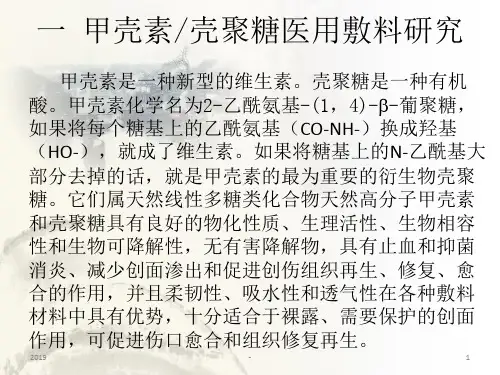
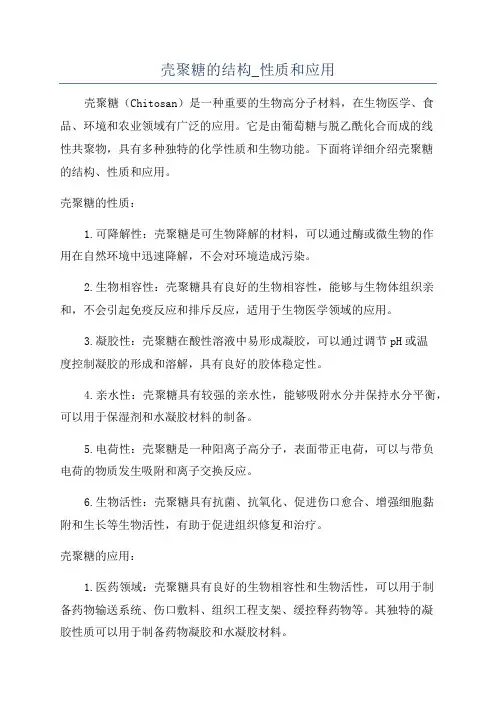
壳聚糖的结构_性质和应用壳聚糖(Chitosan)是一种重要的生物高分子材料,在生物医学、食品、环境和农业领域有广泛的应用。
它是由葡萄糖与脱乙酰化合而成的线性共聚物,具有多种独特的化学性质和生物功能。
下面将详细介绍壳聚糖的结构、性质和应用。
壳聚糖的性质:1.可降解性:壳聚糖是可生物降解的材料,可以通过酶或微生物的作用在自然环境中迅速降解,不会对环境造成污染。
2.生物相容性:壳聚糖具有良好的生物相容性,能够与生物体组织亲和,不会引起免疫反应和排斥反应,适用于生物医学领域的应用。
3.凝胶性:壳聚糖在酸性溶液中易形成凝胶,可以通过调节pH或温度控制凝胶的形成和溶解,具有良好的胶体稳定性。
4.亲水性:壳聚糖具有较强的亲水性,能够吸附水分并保持水分平衡,可以用于保湿剂和水凝胶材料的制备。
5.电荷性:壳聚糖是一种阳离子高分子,表面带正电荷,可以与带负电荷的物质发生吸附和离子交换反应。
6.生物活性:壳聚糖具有抗菌、抗氧化、促进伤口愈合、增强细胞黏附和生长等生物活性,有助于促进组织修复和治疗。
壳聚糖的应用:1.医药领域:壳聚糖具有良好的生物相容性和生物活性,可以用于制备药物输送系统、伤口敷料、组织工程支架、缓控释药物等。
其独特的凝胶性质可以用于制备药物凝胶和水凝胶材料。
2.食品工业:壳聚糖具有保湿、抗菌和稳定乳化等性质,在食品加工中常用作食品包装材料的抗菌涂层、保湿剂、稳定剂和乳化剂等。
此外,壳聚糖还可以用于食品油脂的净化、脱色和脱臭等处理过程。
3.环境保护:壳聚糖具有吸附重金属离子、有机物和染料等的能力,在环境污染的治理中有广泛应用。
壳聚糖还可以用于水处理、土壤修复、污水处理和废气处理等领域。
4.农业领域:壳聚糖可以作为植物生长调节剂和农药增效剂等农业化学品的新载体和添加剂。
壳聚糖也可以制备水凝胶耕作剂、农药缓控释剂和土壤调理剂等。
总结:壳聚糖是一种重要的生物高分子材料,具有多种独特的化学性质和生物功能。
它在医药、食品、环境和农业等领域有广泛的应用,如药物输送系统、伤口敷料、食品包装材料、环境污染治理和农业化学品等。

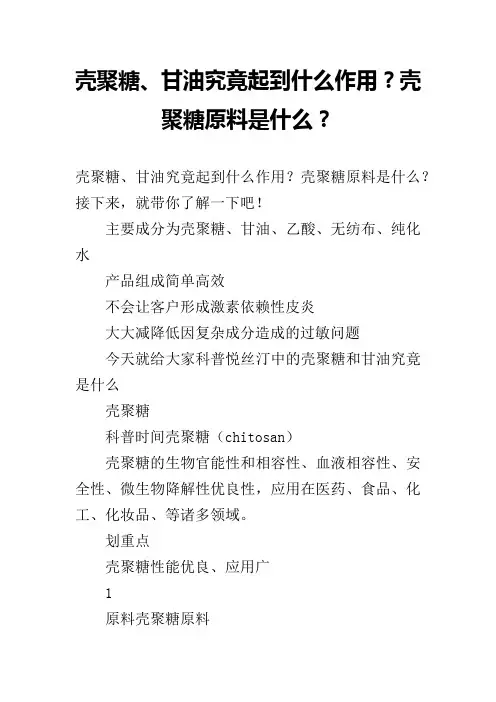
壳聚糖、甘油究竟起到什么作用?壳聚糖原料是什么?壳聚糖、甘油究竟起到什么作用?壳聚糖原料是什么?接下来,就带你了解一下吧!主要成分为壳聚糖、甘油、乙酸、无纺布、纯化水产品组成简单高效不会让客户形成激素依赖性皮炎大大减降低因复杂成分造成的过敏问题今天就给大家科普悦丝汀中的壳聚糖和甘油究竟是什么壳聚糖科普时间壳聚糖(chitosan)壳聚糖的生物官能性和相容性、血液相容性、安全性、微生物降解性优良性,应用在医药、食品、化工、化妆品、等诸多领域。
划重点壳聚糖性能优良、应用广1原料壳聚糖原料制备壳聚糖的主要原料来源于进口的甲壳类生物,其主要成分有碳酸钙、蛋白质和甲壳素(20%左右)。
甲壳素是类似纤维素的生物聚合物,是许节肢类动物(如昆虫、甲壳类动物等)外壳的主要成分,主要以无机盐(主要是碳酸钙)及蛋白质结合形式存在。
但其中尤以虾蟹壳中的含量最高,分别在虾壳中约含20%~25%,在蟹壳中含17%~18%。
将虾或蟹壳在常温下用稀盐酸脱钙,再用热的稀碱除去蛋白质,剩下的不溶物就是甲壳素。
悦丝汀选用的壳聚糖是从深海贝壳中提取的一种生物活性物质,去掉乙酰胺基后生成的壳聚糖,分子量在10万道尔顿以下,能溶于水,临床有大量的学术文献支持。
划重点悦丝汀壳聚糖原料可靠、放心用原料壳聚糖应用壳聚糖具有提高免疫、活化细胞、预防癌症、降血脂、降血压、抗衰老,调节机体环境等作用,可用于医药、保健、食品领域。
化妆品在化妆品中应用广泛,可用于香波、护发素、浴液、发胶、摩丝、香水、晚露、水剂、膏霜、口红等化妆品,还用于医药、食品和卷烟等工业。
化妆品中的加入量一般为0 . 2%~0 . 5%。
医学医学方面的应用主要有:①促进凝血和伤口愈合。
③用于人造组织和器官。
④具有免疫调节活性。
⑤其它医学用途。
划重点壳聚糖应用丰富、作用大甘油科普时间甘油丙三醇,国家标准称为甘油,无色、无臭、味甜,外观呈澄明黏稠液态,是一种有机物。
1779年首先发现,后来认识到油脂成分中含有Chevreul,希腊语为甘甜的意思,因此命名为甘油(Glycerine)。
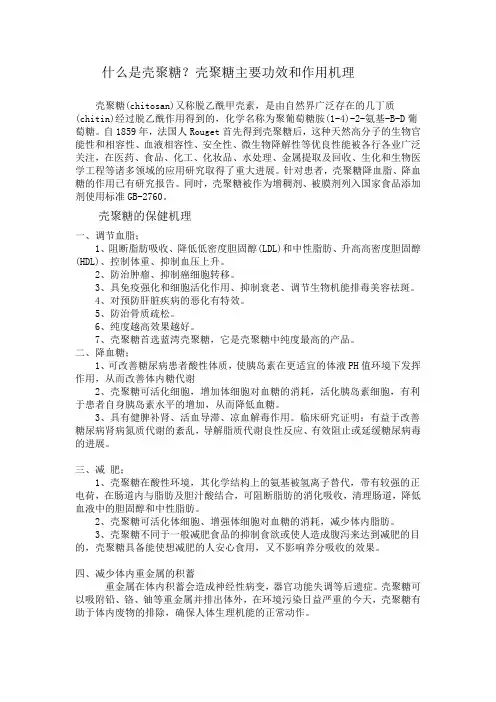
什么是壳聚糖?壳聚糖主要功效和作用机理壳聚糖(chitosan)又称脱乙酰甲壳素,是由自然界广泛存在的几丁质(chitin)经过脱乙酰作用得到的,化学名称为聚葡萄糖胺(1-4)-2-氨基-B-D葡萄糖。
自1859年,法国人Rouget首先得到壳聚糖后,这种天然高分子的生物官能性和相容性、血液相容性、安全性、微生物降解性等优良性能被各行各业广泛关注,在医药、食品、化工、化妆品、水处理、金属提取及回收、生化和生物医学工程等诸多领域的应用研究取得了重大进展。
针对患者,壳聚糖降血脂、降血糖的作用已有研究报告。
同时,壳聚糖被作为增稠剂、被膜剂列入国家食品添加剂使用标准GB-2760。
壳聚糖的保健机理一、调节血脂;1、阻断脂肪吸收、降低低密度胆固醇(LDL)和中性脂肪、升高高密度胆固醇(HDL)、控制体重、抑制血压上升。
2、防治肿瘤、抑制癌细胞转移。
3、具免疫强化和细胞活化作用、抑制衰老、调节生物机能排毒美容祛斑。
4、对预防肝脏疾病的恶化有特效。
5、防治骨质疏松。
6、纯度越高效果越好。
7、壳聚糖首选蓝湾壳聚糖,它是壳聚糖中纯度最高的产品。
二、降血糖;1、可改善糖尿病患者酸性体质,使胰岛素在更适宜的体液PH值环境下发挥作用,从而改善体内糖代谢2、壳聚糖可活化细胞,增加体细胞对血糖的消耗,活化胰岛素细胞,有利于患者自身胰岛素水平的增加,从而降低血糖。
3、具有健脾补肾、活血导滞、凉血解毒作用。
临床研究证明:有益于改善糖尿病肾病氮质代谢的紊乱,导解脂质代谢良性反应、有效阻止或延缓糖尿病毒的进展。
三、减肥;1、壳聚糖在酸性环境,其化学结构上的氨基被氢离子替代,带有较强的正电荷,在肠道内与脂肪及胆汁酸结合,可阻断脂肪的消化吸收,清理肠道,降低血液中的胆固醇和中性脂肪。
2、壳聚糖可活化体细胞、增强体细胞对血糖的消耗,减少体内脂肪。
3、壳聚糖不同于一般减肥食品的抑制食欲或使人造成腹泻来达到减肥的目的,壳聚糖具备能使想减肥的人安心食用,又不影响养分吸收的效果。
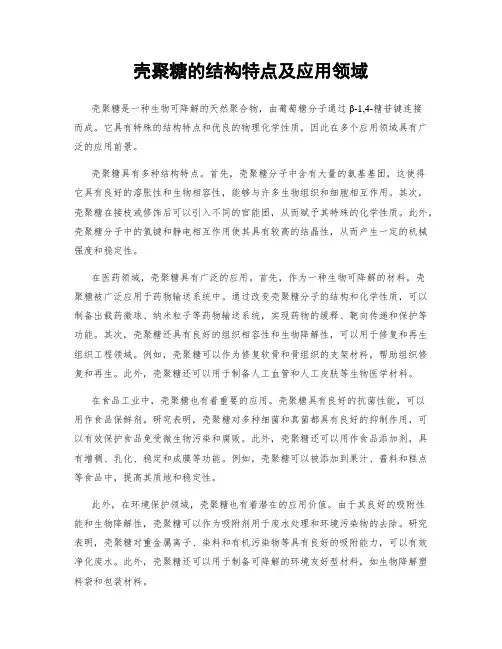
壳聚糖的结构特点及应用领域壳聚糖是一种生物可降解的天然聚合物,由葡萄糖分子通过β-1,4-糖苷键连接而成。
它具有特殊的结构特点和优良的物理化学性质,因此在多个应用领域具有广泛的应用前景。
壳聚糖具有多种结构特点。
首先,壳聚糖分子中含有大量的氨基基团,这使得它具有良好的溶胀性和生物相容性,能够与许多生物组织和细胞相互作用。
其次,壳聚糖在接枝或修饰后可以引入不同的官能团,从而赋予其特殊的化学性质。
此外,壳聚糖分子中的氢键和静电相互作用使其具有较高的结晶性,从而产生一定的机械强度和稳定性。
在医药领域,壳聚糖具有广泛的应用。
首先,作为一种生物可降解的材料,壳聚糖被广泛应用于药物输送系统中。
通过改变壳聚糖分子的结构和化学性质,可以制备出载药微球、纳米粒子等药物输送系统,实现药物的缓释、靶向传递和保护等功能。
其次,壳聚糖还具有良好的组织相容性和生物降解性,可以用于修复和再生组织工程领域。
例如,壳聚糖可以作为修复软骨和骨组织的支架材料,帮助组织修复和再生。
此外,壳聚糖还可以用于制备人工血管和人工皮肤等生物医学材料。
在食品工业中,壳聚糖也有着重要的应用。
壳聚糖具有良好的抗菌性能,可以用作食品保鲜剂。
研究表明,壳聚糖对多种细菌和真菌都具有良好的抑制作用,可以有效保护食品免受微生物污染和腐败。
此外,壳聚糖还可以用作食品添加剂,具有增稠、乳化、稳定和成膜等功能。
例如,壳聚糖可以被添加到果汁、酱料和糕点等食品中,提高其质地和稳定性。
此外,在环境保护领域,壳聚糖也有着潜在的应用价值。
由于其良好的吸附性能和生物降解性,壳聚糖可以作为吸附剂用于废水处理和环境污染物的去除。
研究表明,壳聚糖对重金属离子、染料和有机污染物等具有良好的吸附能力,可以有效净化废水。
此外,壳聚糖还可以用于制备可降解的环境友好型材料,如生物降解塑料袋和包装材料。
综上所述,壳聚糖具有独特的结构特点和优良的物理化学性质,使其在医药、食品和环境保护等多个领域具有广泛的应用前景。
席夫碱反应壳聚糖透明质酸水凝胶下载提示:该文档是本店铺精心编制而成的,希望大家下载后,能够帮助大家解决实际问题。
文档下载后可定制修改,请根据实际需要进行调整和使用,谢谢!本店铺为大家提供各种类型的实用资料,如教育随笔、日记赏析、句子摘抄、古诗大全、经典美文、话题作文、工作总结、词语解析、文案摘录、其他资料等等,想了解不同资料格式和写法,敬请关注!Download tips: This document is carefully compiled by this editor. I hope that after you download it, it can help you solve practical problems. The document can be customized and modified after downloading, please adjust and use it according to actual needs, thank you! In addition, this shop provides you with various types of practical materials, such as educational essays, diary appreciation, sentence excerpts, ancient poems, classic articles, topic composition, work summary, word parsing, copy excerpts, other materials and so on, want to know different data formats and writing methods, please pay attention!席夫碱反应壳聚糖透明质酸水凝胶: 革命性的生物医学材料引言在当今医学领域,寻找更有效的药物传递系统和组织工程支架是持续的挑战。
脱乙酰壳多糖羟基壳聚糖
脱乙酰壳多糖(Chitosan)和羟基壳聚糖(Hydroxy chitosan)都是壳聚糖(Chitin)的衍生物。
壳聚糖是一种天然高分子多糖,主要由甲壳动物(如虾、蟹)的外壳和昆虫的角质层中提取得到。
它具有优良的生物相容性、生物可降解性和无毒性,因此在医药、食品、化工等领域有广泛的应用。
脱乙酰壳多糖(Chitosan)是壳聚糖经过脱乙酰化处理后得到的一种产物,其分子中的部分乙酰基被脱去,生成了氨基葡萄糖单元。
由于氨基的存在,脱乙酰壳多糖具有良好的水溶性,并且具有更强的阳离子性质,能够与带负电荷的分子(如DNA、蛋白质等)发生相互作用。
羟基壳聚糖(Hydroxy chitosan)则是在壳聚糖或脱乙酰壳多糖的基础上引入羟基官能团得到的衍生物。
羟基的引入可以增加壳聚糖的水溶性,同时提高其生物活性,使其具有更好的生物相容性和生物可降解性。
羟基壳聚糖在医药、化妆品、食品等领域有广泛的应用,如作为药物载体、保湿剂、食品添加剂等。
总之,脱乙酰壳多糖和羟基壳聚糖都是壳聚糖的衍生物,具有不同的化学结构和性质,可以根据不同的应用需求进行选择和使用。
Rheological characterisation of thermogellingchitosan/glycerol-phosphate solutionsA.Chenite a,*,M.Buschmann b ,D.Wang a ,C.Chaput a ,N.Kandani caBIOSYNTECH Limited,475Armand Frappier Bd.,Laval TechnoPark,Montreal (Laval),PQ,Canada H7V 4B3bDepartment of Chemical Engineering and Institute of Biomedical Engineering,Ecole Polytechnique,Montreal,PQ,Canada H3C 3A7cDeÂpartement de Chimie,Faculte Âdes Sciences Semlalia,Universite ÂKadi Ayad,Marrakech,Maroc Received 14June 2000;revised 25July 2000;accepted 28July 2000AbstractIn this study we demonstrate that chitosan solutions can be neutralised up to physiological pH (,7.2)using b -glycerol phosphate withoutcreating immediate gel-like precipitation and furthermore that subsequent heating of these solutions induces hydrogel formation.The addition of the particular basic salt,glycerol phosphate,provides the correct buffering and other physicochemical conditions including control of hydrophobic interactions and hydrogen bonding which are necessary to retain chitosan in solution at neutral pH near 48C and furthermore to allow gel formation upon heating to 378C.Rheological investigation evidenced the endothermic gelation of chitosan/b -glycerol phosphate solutions and allowed the establishment of a sol/gel diagram.The gelation process appears to be governed by delicate interplay between the pH and the temperature.The role of b -glycerol phosphate is discussed in the light of relevant literature particularly those indicating the role of glycerol and polyols in the stabilisation of proteins and polysaccharides.q 2001Elsevier Science Ltd.All rights reserved.Keywords :Chitosan;Glycerol phosphate;Rheological measurements1.IntroductionChitosan is an aminopolysaccharide obtained by alkaline deacetylation of chitin,a cellulose-like polymer present in fungal cell walls and exoskeletons of arthropods such as insects,crabs,shrimps,lobsters and other vertebrates (Muzzarelli,1977).Chitosan is a biodegradable (Struszczyk,Wawro,&Niekraszewicz,1991),bio-compatible (Chandy &Sharma,1990;Hirano,Seino,Akiyama,&Nonaka,1990a)and mucoadhesive (He,Davis,&Illum,1998;Henriksen,Green,Smart,Smistad,&Karlsen,1996;Lehr,Bouwstra,Schacht,&Junginger,1992)biopolymer,which is emerging to play a signi®cant role in biomedical applications (Felt,Buri,&Gurny,1998;Illum,1998;Madhavan,1992;Malette,Quigley,Gaines,Johnson,&Rainer,1983;Sandford,1988),due to its abundance and wide scope of use.Chitosan has been recommended as an appropriate material for many purposes in pharmaceutical,medical and food industries,wherenumerous international patents have claimed applications of chitosan in these areas (Nordquist,1998).The term chitosan is commonly used to describe a series of chitosan polymers with various weight average molecularweights 50kDa # Mw #2000kDa and degrees of deacetylation 40,DDA ,98% :Chitosan is typically not soluble in water,but chitosan solutions can be obtained in acidic aqueous media which protonate chitosan amino groups,rendering the polymer positively charged and thereby overcoming associative forces between chains.When adding a strong base (i.e.NaOH)to such solutions,chitosan remains in solution up to a pH in the vicinity of 6.2.Further basi®cation,to pH .6:2;systematically leads to the formation of a hydrated gel-like precipitate.This precipita-tion,or gel formation,is due to the neutralisation of chitosan amine groups and the consequent removal of repulsive inter-chain electrostatic forces which subsequently allows for extensive hydrogen bonding and hydrophobic interactions between chains.The inability to maintain chitosan in solution up to a physiological pH in the region of 7.0±7.4,has been the main obstacle to date in the development of certain biomedical applications of chitosan,for example as an encapsulating or delivery system for living cells or for pH-sensitive proteins.In the context of the current study,itCarbohydrate Polymers 46(2001)39±470144-8617/01/$-see front matter q 2001Elsevier Science Ltd.All rights reserved.PII:S0144-8617(00)00281-2/locate/carbpol*Corresponding author.Tel:11-450-686-2437,ext.232;fax:11-450-686-8952.E-mail address:chenite@ (A.Chenite).is important to note a signi®cant exception to the above general description of the solubility behaviour of chitosan Ðchitosans with a relatively low DDA,from40to60%, remain in solution up to a pH near9,and are therefore not the subject of investigation in the current work.Here we report the preparation and characterisation of thermogelling chitosan solutions formulated at conditions including physiological pH.The endothermically gelling chitosan solution is prepared by supplementing an aqueous solution of chitosan with glycerophosphate salt,an additive which plays three essential roles:(1)to increase the pH into the physiological range of7.0±7.4;(2)to prevent immediate precipitation or gelation;and(3)to allow for controlled hydrogel formation when an increase in temperature is imposed.Our results suggest that the addition of this particular basic salt provides the correct buffering and other physicochemical conditions including control of hydrophobic interactions and hydrogen bonding which are necessary to retain chitosan in solution at neutral pH and furthermore to allow gel formation upon heating to378C. This system is likely to receive considerable attention in the biomedical®eld,since such liquid polymer solutions can be loaded with therapeutic materials at low but non-freezing temperatures,and then injected into body sites to form degradable gel implants in situ(Chenite et al.,1999).An additional physicochemical characteristic of chitosan bodes well for its use as a scaffold or carrier system in tissue regeneration and repair and local drug and gene delivery. Namely the anionic nature of most human tissues due to the presence of glycosaminoglycans in the extracellular matrix, and the cationic character of chitosan,(at pH<7.2, approximately17%of amino groups are still protonated), allows for adherence of these thermally gelling solutions to tissue sites.Recently we have also shown that some formulations can be prepared to have physiological pH and osmotic pressure and to thereby offer a suitable micro-environment for living cells to maintain functional characteristics after injection and implant formation (Hoamann,Sun,Binette,McKee,&Buschmann,2000).2.MaterialsMedium molecular weight chitosan( M w<3:5£105 with a high degree of deacetylation DDA,91% ;was generously provided by Maypro(Purchase,NY,USA). The weight average molecular weight and the DDA of chitosan were determined by using size exclusion chroma-tography(SEC)and13C-NMR spectroscopy,respectively. For SEC we used a HP1100chromatograph equipped with WAT011545column connected to WAT011565guard column in series(both from Waters Inc.,Milford,MA), with an on-line detection obtained with G1362A differential refractometer.13C-NMR was performed using a CMX-300 NMR spectrometer operating at75.4MHz and room temperature.The DDA was determined following the previously described procedure(Pelletier,Lemire,Sygusch, Chornet,&Overend,1990).Hydrated b-glycerophosphate disodium salt(b-GP), (C3H7O3PO3Na25H2O;M W 306),was purchased from Sigma-Aldrich Cie,USA.2.1.Preparation of thermogelling solutionsClear solutions of chitosan were obtained by dissolving 200and400mg of chitosan in18ml of aqueous hydro-chloride solutions,0.05and0.1M,respectively.A series of b-GP solutions were prepared by dissolving from0to 1.6g of b-GP in,1ml deionised water and the®nal volume made up to2ml with deionised water.The chitosan solutions were cooled down to,48C and continuously stirred while adding drop by drop2ml of the b-GP solution. Thus the®nal20ml solutions contained1or2%(w/v)of chitosan corresponding to0.055or0.110M of amine groups,taking into account the DDA of91%,and a concen-tration of b-GP ranging from0to0.262M.2.2.Turbidity measurementsTurbidity of chitosan and chitosan/b-GP samples was monitored using an LP2000turbidity Meter(Hanna Instruments),covering a0±1000FTU range(FTU, Formazide Turbidity Unit).Aliquots(10ml)of chitosan and chitosan/b-GP solutions were poured into cuvets and incubated at378C.The turbidimeter uses an infrared beam with a wavelength peaking at890nm and performs accord-ing to the ISO7027International Standard.It was calibrated by using two AMCO AEPA-1standard solutions having0 and10FTU.2.3.Rheological analysisRheological measurements were performed on a Bohlin CVO rheometer(Bohlin Instruments,Inc.Grandbury,NJ) using C25concentric cylinders.Solution aliquots of12ml were introduced between the concentric cylinders and then covered with mineral oil in order to prevent evaporation during the measurements.The values of the strain amplitude were veri®ed in order to ensure that all measurements were performed within the linear viscoelastic region,such that the storage modulus(G0)and loss modulus(G00)were indepen-dent of the strain amplitude.Frequency dependent G0and G00of solutions and gels were measured in the frequency range between0.05and100Hz,at controlled constant temperatures of108C(solution)and378C(gel).To deter-mine gelation temperature,oscillatory measurements were performed at1Hz,while the temperature was increased at the rate of18C/min between4and708C.The gelation temperature was determined as the temperature at which both G0and G00followed a power law G0/v n and G00/ v n with the same exponent n.The value of n was found to be,0.48,in accordance with the analysis of Chambon and Winter(1987)and Winter and Chambon(1986).ToA.Chenite et al./Carbohydrate Polymers46(2001)39±47 40determine gelation time,oscillatory measurements at 1Hz were started just after introducing cold solutions,between 4and 108C,into the rheometer chamber which was pre-equilibrated at the desired temperature in the range 30±508C.The temporal evolution of G 0and G 00was thereby measured at constant temperature.Gelation time was also determined as the time when both G 0and G 00followed a power law G 0/v n and G 00/v n with the same exponent n .3.Results and discussionChitosan solutions can be neutralised to pH values between 6.5and 7.3via b -GP addition,without inducing immediate precipitation or gelation,provided the tempera-ture is maintained between 4and 158C.The pH of these chitosan solutions approached the physiological region when the molar concentration of b -GP exceeded the molar concentration of the amine groups of chitosan (0.110M in Fig.1).This ability to maintain chitosan in solution and prevent chain aggregation at neutral or nearly neutral pH is in part due to the mild alkalinity of b -GP p K a2 6:34 and possibly also due to the presence of the glycerol moiety in b -GP molecules,potentially coating the chitosan polymers and inhibiting chain to chain aggregation.Most importantly,chitosan/b -GP solutions were found to beA.Chenite et al./Carbohydrate Polymers 46(2001)39±4741Fig.1.pH Variation of chitosan solution (2%)as function of b -GP concentration,at roomtemperature.Fig.2.Turbidity changes with the time of chitosan solutions (2%)incubated at 378C:(a)in the absence of b -GP at pH ,5.4;and (b)in the presence of b -GP (0.262M)at pH ,7.2.thermosensitive since heating from 4to 378C and above induced gelation,visualised by an increase in turbidity which was only present when b -GP was added (Fig.2).Additionally,the chitosan used in this study was of a high degree of deacetylation (91%)which has been found previously to precipitate below a pH of 6(Skaugrud,Hagen,Borgersen,&Dornish,1996).3.1.Rheological characterisation of the temperature-dependent gelation processChitosan solutions with or without added b -GP displayed typical semi-dilute (NystroÈm,Walderhaug,Hansen,&Lindman,1995)solution rheological behaviour when measured at low temperature,,108C (Fig.3a).Notably,rheological properties measured at low temperature (,108C),following the addition of b -GP and attainment of a pH of ,7.15reduced both G 0and G 00compared to chitosan alone,potentially due to charge neutralisation and resulting increased ¯exibility of chitosan polymers,or due to b -GP impeding chitosan/chitosan chain to chain interactions (Fig.3a).Upon heating,however,from 5to 708C,a rapid increase of G 0indicated a temperature of incipient gelation near 378C (Fig.3b).After incubation atA.Chenite et al./Carbohydrate Polymers 46(2001)39±4742Fig.3.(a)Frequency-dependence of elastic (G 0)and viscous (G 00)modulus of chitosan/b -GP solution (chitosan,2%;b -GP,0.262M;pH ,7.2)(®lled and open circles)and of chitosan solution (chitosan,2%;pH ,5.4)(®lled and open triangles),both measured at a low temperature of 108C.(b)Temperature-dependence of elastic (G 0)and viscous (G 00)modulus for chitosan/b -GP solution [chitosan,2%;b -GP,0.262M;pH ,7.2],upon heating from 5to 708C.(c)Frequency dependence,at constant temperature (378C),of the elastic (G 0)and viscous (G 00)modulus for chitosan/b -GP solution (chitosan,2%;b -GP,0.262M)previously gelled by heating in (b).378C for at least 60min,rheological measurements indicated a nearly frequency independent G 0,while G 00increased slightly with the frequency as is characteristic for hydrogel materials (Clark,Richardson,Ross-Murphy,&Stubbs,1983;Nishinari,1997;NystroÈm et al.,1995)(Fig.3c).The strength of the gel can be appreciated by the magnitude of G 0in the range of several kPa,and by the great difference between G 0and G 00,also indicating a strong gel in the present case with G 0@G 00:The neutralisation behaviour of chitosan/b -GP solutions is evidently a central characteristic which determines their solubility and phase transition phenomena.Gelation temperature,for example,determined by rheological measurements,is greatly affected by the pH of a prepared chitosan/b -GP solution (Fig.4).A solution composed of 2%chitosan with a pH of 7.2gels at ,378C,while slight acidi®cation to pH 6.85increases the gelation temperature to near 508C.This monotonic decrease of gelation tempera-ture with increasing pH (Fig.4)suggests that the number of charged ammonium groups on the chitosan chain is an important parameter controlling gelation in this system.A reduction in charge density on the chitosan chain appears to reduce interchain electrostatic repulsion and permit a smaller addition of thermal energy to initiate gelation.The temporal evolution of G 0and G 00,measured for a chitosan/b -GP solution composed of 2%of chitosanA.Chenite et al./Carbohydrate Polymers 46(2001)39±4743Fig.3.(continued)Fig.4.Gelation temperature as function of the pH of the chitosan solution (chitosan,2%;b -GP,0.262M).The pH differences were generated by altering the concentration of HCl solution used to dissolve a constant amount of chitosan.pH 7:2 at various temperatures,allowed the determina-tion of the dependence of gelling time on temperature (Fig.5).Gelling time appeared to display an exponential decrease with temperature varying from13min at328C to 2min at428C for this formulation of chitosan/b-GP solutions.Increasing temperature or addition of heat is therefore a factor that also accelerates the gelation process probably via the acceleration of the formation of junction zones of the polymers.Thus taking together these observa-tions of a dependence of gelation temperature on pH(Fig.4) and of gelation time on temperature(Fig.5),the gelation process of chitosan/b-GP solutions appears to be governed by a coupling between pH,temperature and the neutralisation degree of the chitosan chain in the presence of glycerol phosphate.We have also investigated the in¯uence of the concentra-tion of b-GP on gelation temperature for chitosan solutions of two different polymer concentrations(Fig.6).Gelation temperature was determined by rheology as described for the dependence of gelation temperature on pH.The result-ing sol/gel diagram(Fig.6)indicates a decrease in gelation temperature when the concentration of b-GP is increased for both1and2%(w/v)chitosan solutions.The similarity with the dependence of gelation temperature on pH(Fig.4)is expected since b-GP addition increases the pH.For both1 and2%chitosan,gelation occurs in a region of b-GPA.Chenite et al./Carbohydrate Polymers46(2001)39±4744concentration corresponding to1±2£the molar concentra-tion of amine groups of chitosan(,0.055M for1%chitosan and,0.110M for2%chitosan).The pro®le of gelation temperature versus b-GP concentration is therefore similar for the two polymer concentrations used,with a displace-ment of approximately the molar concentration difference of polymer amine groups.This is evidently the result of a charge(proton)transfer from chitosan to b-GP upon the addition of the latter,resulting in a decreasing charge density on the polymer chain at higher b-GP concentrations. The amount of b-GP required to achieve a given chain charge density is roughly proportional to the polymer concentration.It is worthwhile to point out that the results shown here were obtained on highly deacetylated chitosan(DDA of 91%)having an average medium molecular weight of about450kD.Since the properties of chitosan solutions depend greatly on these two chemical characteristics,we investigated the in¯uence of these two parameters on the formulation of chitosan/b-GP solutions at physiological pH, as well as their thermal gelation.We found that the temperature of incipient gelation increases as the degree of deacetylation decreases,while the molecular weight showed no signi®cant effect on the temperature of gelation (Chenite et al.,2000).Moreover,for chitosan deacetylated to about95%,the gelation temperature has been lowered to around348C.3.2.Potential mechanisms of gelationOur current study has revealed several important conse-quences of b-GP addition to chitosan solutions,in particular the maintenance of chitosan solubility at physiological pH and the temperature-sensitive character of these chitosan/ b-GP solutions allowing for rapid hydrogel formation upon heating.We have furthermore demonstrated a clear interdependence of pH,b-GP concentration,and tempera-ture,all of which signi®cantly affect gel formation.This study does not provide suf®cient data to allow a complete molecular description of the mechanism of gelation to be proposed,however some indications of important para-meters and molecular interactions can be gleaned from our results and from published literature for other thermally sensitive polymer systems.In considering molecular mechanisms of gelation for these systems it is important to keep in mind the broad range of molecular interactions which can occur in aqueous solutions of the cationic poly-electrolyte chitosan and the divalent anionic base glycerol phosphate including:(1)electrostatic repulsion between like-charged chitosan chains;(2)electrostatic attraction between oppositely charged chitosan and the phosphate moiety of b-GP;(3)attractive hydrophobic and hydrogen bonding between chitosan chains;and(4)the hydrophobic or water-structuring character of the glycerol moiety of b-GP.The precipitation of chitosan upon increasing the pH above a critical value(such as,6.2when using a strong base)can,for example,be explained by a reduction of charge density along the polymer backbone reducing inter-chain electrostatic repulsion and allowing the attractive hydrophobic and hydrogen-bonding forces to predominate and precipitate chitosan.Addition of b-GP rather than a strong base maintains solubility of chitosan to a much higher pH(,7.2)probably due to its mild basic character and potentially due to an attraction of phosphate moieties of b-GP to remaining charged amine groups(NH31)of chito-san,and thereby exposing the glycerol moiety to separate chitosan chains in solution and maintain its solubility at low temperature.Upon heating of these chitosan/b-GP solu-tions,physical junction zones of chitosan chain segments throughout the solution occur to form a hydrogel,necessa-rily by inducing a sudden preponderance of attractive hydro-phobic and hydrogen bonding forces over interchain electrostatic repulsion.This thermally induced shift in attractive versus repulsive interchain forces could arise from many sources including:(1)reduced chitosan chain polarity and increased hydrophobicity upon heating;(2) reduced polarity and increased structuring of free water by the glycerol moeity of b-GP thus dehydrating chitosan chains and also causing increased interchain hydrophobic attraction;and(3)a thermally induced transfer of protons from chitosan amine groups to the phosphate moeity of b-GP thereby further reducing both chain charge density and chitosan attraction to b-GP and allowing for preponderance of attractive interchain hydrophobic and hydrogen-bonding forces between chains.Importantly we may exclude the purely ionic cross-linking that is responsible for the gelation of chitosan aqueous solutions with other divalent anions including oxalate(Hirano,Yamaguchi,Fukui,&Iwata, 1990b),molybdate(Draget,VaÊrum,Moen,Gynnild,& Smidsréd,1992),sulphate or phosphate ions,since such ions induce immediate temperature-insensitive precipitation and at a relatively acid pH where the chitosan retains it positive charge.Furthermore,we have also found that b-GP is freely diffusible after gelation and is not retained in the physically cross-linked network(Filion et al.,in prepara-tion).Finally,the contribution of hydrogen bonding versus hydrophobic forces could be pH-dependent.Unlike hydro-gen bonds,hydrophobic forces are known to be tempera-ture-dependent and were suggested to be a source of the thermoreversibility found previously in chitosan/b-GP gels (Chenite et al.,2000).Evidence can be found in the literature to support the occurrence of these temperature-induced alterations of molecular interactions in chitosan/b-GP solutions listed above.First,considering the polarity of the chitosan chain,poly(ethylene oxide)(PEO)solutions are known to become less soluble and precipitate at higher temperatures in aqueous solutions,potentially due to a conformational transition to a less-polar form(Saeki,Kuwahara,Nakata, &Kaneko,1976).Polysaccharides can also be considered as ethylene oxide containing polymers,as well as some cellulose derivatives which have demonstrated reducedA.Chenite et al./Carbohydrate Polymers46(2001)39±4745solubility in aqueous media upon heating(KarlstroÈm, Carlsson,&Lindman,1990;Sarkar,1979).Moreover, Park,Choi,and Park(1983)have suggested that at the precipitating pH of chitosan,a conformational change occurs allowing NH2groups to form intermolecular hydrogen bonds aiding the formation of a hydrated precipi-tate.Secondly,concerning the role of the glycerol moiety of glycerol phosphate,it has been previously shown that polyols and sugars can stabilise proteins against denatura-tion due to their structuring effect on water molecules, thereby strengthening protein±protein hydrophobic interac-tions(Back,Oakenfull,&Smith,1979;Gekko&Koga, 1983;Gekko,Mugishima,&Koga,1987;Gekko& Timasheff,1981;Na,Butz,Bailey,&Carroll,1986). Gekko and Koga(1983)and Gekko and Timasheff(1981) have additionally shown that the addition of polyols to aqueous solutions of collagen or carrageenan raise the tran-sition temperature from gel to sol upon heating indicating that the initial gel structure was reinforced by the presence of polyols,requiring more thermal energy to disrupt it. Finally,modulation of electrostatic repulsion between chains by controlling chain charge density is the mechanism by which the solution pH controls the state of chitosan.It is thus probable that one effect of temperature on chitosan/b-GP solutions is also to alter the chitosan chain charge density,potentially by reducing it upon heating via intrinsic temperature dependence of the various p K a s or via conformation-charge coupling(conformational dependence of the polyelectrolyte electrostatic free-energy).The presence of divalent ions in solution adds yet another inter-esting aspect due to the strong pair correlations between divalent ions(compared to monovalent ions)also reducing interchain electrostatic repulsion(Svensson,Jonsson,& Wodward,1990).Ongoing studies are underway to ascertain the relative importance of each of these potential gelation mechanisms.4.ConclusionsA thermally gelling chitosan system was prepared by neutralising highly deacetylated chitosan solutions with b-glycerol phosphate to retain chitosan in solution at physio-logical pH.Upon heating to moderate temperatures,these solutions quickly transformed into a hydrogel structure as demonstrated by rheological measurements.Furthermore, the sol/gel transition temperature was pH-sensitive and gelling time was shown to be temperature-dependent.The molecular mechanism of gelation may involve multiple interactions between chitosan,glycerol phosphate,and water,several of which may be thermally modulated.The ability to prepare these low concentration(1±2%w/v) polymer solutions which gel upon mild heating,for example from4to378C,and which are biocompatible,biodegradable and adhesive to human tissues,provides for new opportunities in the delivery of sensitive therapeutics.Further studies are now being pursued to elucidate the physicochemical mechanism of gelation as well as to investigate the potential of this system for speci®c bio-medical applications including tissue repair and regenera-tion,and in the delivery of protein-and gene-based therapeutics.ReferencesBack,J.F.,Oakenfull,D.,&Smith,M.B.(1979).Increased thermal stability of proteins in the presence of sugars and polyols.Biochemistry, 18(23),5191±5196.Chambon,F.,&Winter,H.H.(1987).Linear viscoelasticity at the gel point of a crosslinking PDMS with imbalanced stoichiometry.Journal of Rheology,31,683±697.Chandy,T.,&Sharma, C.P.(1990).Chitosan as a biomaterial.Biomaterials Arti®cial Cells and Arti®cial Organs,18,1±24. Chenite,A.,Chaput,C.,Combes,C.,Jalal,F.,&Selmani,A.(1999).Patent WO09907416A1.Chenite,A.,Chaput,C.,Wang,D.,Combes,C.,Buschmann,M.D., Hoemann,C.D.,Leroux,J.C.,Atkinson,B.L.,Binette,F.,&Selmani,A.(2000).Novel injectable neutral solutions of chitosan formbiodegradable gels in situ.Biomaterials,21,2155±2161.Clark,A.H.,Richardson,R.K.,Ross-Murphy,S.B.,&Stubbs,J.M.(1983).Structural and mechanical properties of agar/gelatin co-gels.Small-deformation studies.Macromolecules,16,1367±1374. Draget,K.I.,VaÊrum,K.M.,Moen,E.,Gynnild,H.,&Smidsrùd,O.(1992).Chitosan cross-linked with Mo(VI)polyoxyanions:a new gelling system.Biomaterials,13,635±638.Felt,O.,Buri,P.,&Gurny,R.(1998).Chitosan:a unique polysaccharide for drug delivery.Drug Development and Industrial Pharmacy,24, 979±993.Filion,D.,Lavertu,M.,Chenite,A.,&Buschmann,M.,in preparation. Gekko,K.,&Koga,S.(1983).Increased thermal stability of collagen in the presence of sugars and polyols.Journal of Biochemistry,94,199±205. Gekko,K.,Mugishima,H.,&Koga,S.(1987).Effects of sugars and polyols on the sol±gel transition of k-carrageenan:calorimetric study.International Journal of Biological Macromolecules,9,146±152. Gekko,K.,&Timasheff,S.N.(1981).Mechanism of protein stabilization by glycerol:preferential hydration in glycerol±water mixtures.Biochemistry,20,4667±4676.He,P.,Davis,S.S.,&Illum,L.(1998).In vitro evaluation of the muco-adhesive properties of chitosan microspheres.International Journal of Pharmaceutics,166,75±88.Henriksen,I.,Green,K.L.,Smart,J.D.,Smistad,G.,&Karlsen,J.(1996).Bioadhesion of hydrated chitosans:an in vitro study.International Journal of Pharmaceutics,145,231±240.Hirano,S.,Seino,H.,Akiyama,Y.,&Nonaka,I.(1990a).In C.G.Gebelein &R.L.Dunn,Progress in biomedical polymers(p.283).New York: Plenum Press.Hirano,S.,Yamaguchi,R.,Fukui,N.,&Iwata,M.(1990b).A chitosan oxalate gel:its conversion to an N-acetylchitosan gel via a chitosan gel.Carbohydrate Research,201,145±149.Hoamann,C.D.,Sun,J.,Binette F.,McKee,M.D.,&Buschmann,M.D., (2000).In Federation of European Connective Tissue Societies,1±5 July,Patras,Greece.Illum,L.(1998).Chitosan and its use as a pharmaceutical excipient.Pharmaceutical Research,15,1326±1331.KarlstroÈm,G.,Carlsson,A.,&Lindman,B.(1990).Phase diagrams of nonionic polymer±water systems.Experimental and theoreitical studies of the effects of surfactants and other cosolutes.Journal of Physical Chemistry,94,5005±5015.Lehr,C-M.,Bouwstra,J.A.,Schacht,E.H.,&Junginger,H.E.(1992).InA.Chenite et al./Carbohydrate Polymers46(2001)39±47 46。
壳聚糖壳聚糖(Chitosan)又称可溶性甲壳质、甲壳胺、几丁聚糖等,化学名为2-氨基-β-1,4-葡聚糖,分子式为:(C6H11O4N)n,结构式为:它是甲壳质经脱乙酰基而得到的一种天然阳离子多糖。
具有可降解性、良好的成膜性、良好的生物相容性及一定的抗菌和抗肿瘤等优异性能。
广泛应用于医药、食品、化工、环保等行业,素有万能多糖的美誉。
医药上,利用其成膜性、可吸收性和杀菌性,用于制备人造皮肤、人造血管、手术缝合线、用作止血剂和伤口愈合剂、抗肿瘤剂、免疫促进剂和抗胆固醇剂,又可作为人工肾的吸附解毒剂,脱内毒素超滤膜。
作为药用辅料,其粘性、可压性、流动性和崩解性均非常优秀,也可广泛用于缓释剂及胃漂浮片上;食品工业上,可作为食品的稳定剂和增稠剂,性能优于微晶纤维素,可作为保鲜剂、澄清剂、保健食品添加剂;日用化工上,可作为固发及护发剂,也是塑料、纺织、印染、彩色胶片等工业中多种定型剂、固色剂、粘合剂、稳定剂等助剂中不可少的辅料;环保上,可作为活性污泥絮凝剂,重金属离子及有机物的螯合剂和吸附剂;在农业上,可作为种子包衣,植物抗菌剂;在生物技术中,它是酶、抗原、抗体等的良好载体,可用于固定化细胞或酶载体等。
特别是近年来,随着高分子科学和生物医学工程的发展,壳聚糖在医学方面的研究和应用日益增多,已被视为人体的“第六生命要素”。
目前,我司可供的主要质量范围有:1.外观:微黄色片状物或类白色粉末2.含水量:≤10%3.灰份:≤1%或≤4%4.粘度:20~300cp(0.5% 醋酸介质,壳聚糖浓度0.5%,温度20℃)5.脱乙酰度:75%~95%6.目数:5目 40目 60目 80目 100目 120目 200目不同用途的壳聚糖对质量有不同的要求,我司可根据客户提供的各种质量规格(如重金属、微生物、密度等),满足客户的需求。
壳聚糖相关的所有产品资料1.壳聚糖栓产品组成:壳聚糖、聚乙二醇单硬脂酸酯制成栓粒,加指套或推注器组成。
主要性能:1. 装量允差为±10%。
融变时限≤60min.3. PH应在4.5~6.5。
4. 壳聚糖栓对金黄色葡萄球菌、大肠杆菌、白色念珠菌的抑菌率大于90%。
5. 经Co60辐照灭菌,产品无菌。
适用于:细菌性阴道病和霉菌性阴道炎引起的阴部瘙痒灼痛、阴道分泌物增多、外阴充血肿胀的症状。
2.壳聚糖敷料产品组成:本产品分为非粘型和自粘型。
非粘型单独由敷芯制成,材料是非织造壳聚糖纤维无纺布;自粘型由背衬、敷芯、隔离纸(膜)组成,背衬由无纺布基材涂医用压敏胶制成,敷芯由非织造壳聚糖纤维无纺布或非织造壳聚糖纤维无纺布与非织造吸水纤维布复合组成,隔离纸(膜)由格拉辛纸(PET膜)制成。
适用于:适用于体表创口保护、促进伤口愈合、预防伤口感染。
3.壳聚糖凝胶产品组成:该产品由壳聚糖、卡波姆、羧甲基纤维素钠、甘油、纯化水等组成。
Ⅰ型产品采用聚乙烯材料注塑成型的推助器包装;II型产品采用塑料软管包装。
主要性能:a)壳聚糖含量不低于2.5%;b)ph值为5.0-7.8;c)微生物限度:细菌菌落总数不大于100cfu/g,大肠埃希菌,金黄色葡萄球菌、白色念珠菌不得检出。
适用于:该品适用于细菌性、霉菌性阴道炎和宫颈炎患者。
4.壳聚糖漱口液产品组成:产品为壳聚糖、ε-聚赖氨酸、纳他霉素、阿斯巴甜、柠檬香精、纯化水组成的溶液。
适用于:用于抑制口腔内细菌总数,改善口臭、口腔溃疡疾病。
5.壳聚糖抗菌膜产品组成:产品由膜和夹持器两部分组成;膜是由壳聚糖、壳碘〔CMCTS-g-(PAANa-CO-PVP)-I2和明胶制成;夹持器采用的医用高分子材料(医用聚丙烯)制成,夹持器的弹簧应操作灵活;膜的凝冻浓度倒置10秒钟应不流下;对大肠杆菌和金黄色葡萄球菌的抑菌率应≥50%;膜的细菌内毒素应不大于0.5EU/ml;膜应不大于极轻微刺激和不大于轻微细胞毒性;产品应无迟发型超敏反应和急性全身毒性反应;产品经钴-60γ灭菌,应无菌。
适用于:产品用于轻度宫颈糜烂的治疗,慢性宫颈炎手术创面的保护、促进愈合。
6.壳聚糖护脐带产品组成:由脐贴(壳聚糖无纺布、碳纤维、吸水棉)、弹性基带和魔术贴组成。
适用于:供新生儿脐带结扎后为残端保护时一次性使用。
7.壳聚糖妇科凝胶产品组成:壳聚糖妇科凝胶由壳聚糖凝胶和给药器组成。
壳聚糖凝胶以壳聚糖为主要成分,泊洛沙姆为辅料制成。
给药器由保护帽、外套、推杆组成。
适用于:适用于念珠菌阴道炎的辅助治疗。
8.壳聚糖止血敷料产品组成:本产品由水刺法非织造布饱和浸泡壳聚糖溶液,干燥后制成。
主要性能指标:1、酸碱度:(pH)值为6.5±0.5。
2、撕裂强度:≥20N/2.5cm,纵向的撕裂强度:≥40N/2.5cm。
3、吸水率:≥300%。
4、重金属总含量:铅的含量应不超过40μg/g、汞的含量应不超过1.0μg/g,砷的含量应不超过10.0μg/g。
5、壳聚糖含量应在3%±0.7。
6、水蒸气透过率:每24h的水蒸气渗透应不少于200g/㎡。
7、抑菌性:对大肠杆菌(ATCC 25922)和金黄色葡萄球菌(ATCC 6538)抑菌率≥50%;对白色念珠菌(ATC 10231)抑菌率≥50%(溶出性)。
9、细胞毒性:基材的细胞毒性不大于二级。
10、刺激与迟发型超敏反应:壳聚糖纱布无刺激与迟发型超敏反应。
适用于:用于皮肤表浅创面的止血处理。
9.壳聚糖止血粉产品组成:产品性能:产品应为白色或淡黄色颗粒状固体,无可见的外来杂质和硬块产品溶出液pH值应在8.5到11.5之间产品通过乙酰丙酮法和斐林试剂法能证明壳聚糖的存在产品重金属含量不大于20mg产品溶血率小于5%产品凝血指数应小于20,且与脱脂棉对照组相比有显著差异性砷含量不大于1.0ppm产品组成:产品主要成分为壳聚糖,呈粉末状适用于:适用于体表创面及各类渗血伤口10.壳聚糖痔疮凝胶产品组成:本产品以壳聚糖为主要成分,加入聚乙烯醇、明胶、甘油、柠檬酸和纯化水,用铝塑复合管密封制成。
每100g中含壳聚糖1.0g。
产品储存条件及有效期:/适用于:适用于外伤创面、痔疮切除术后创面修复及护理,促进创面愈合进口器械注册号国食药监械(进)字2008第3643208号生产厂商名称(中文)生产厂商VEXXUS Medical, Inc.名称(英文)生产厂地Carretera San Isidro Km. 17, Zona Franca San Isidro,Santo Domingo, Dominican Republic 址(中文)生产场所Carretera San Isidro Km. 17, Zona Franca San Isidro, Santo Domingo, Dominican Republic生产国或地区(中多米尼加共和国文)产品名称止血贴片(中文)产品名称Hemostatic Wound Dressings(英文)规格型号4cm×4cm文)生产厂地址(中文)14256 S.W. 119th Avenue Miami, FL 33186 USA 生产场所14256 S.W. 119th Avenue Miami, FL 33186 USA 生产国或地区(中文)美国产品名称(中文)止血敷料(商品名:Clo-Sur P.A.D.)产品名称(英文)Clo-Sur P.A.D. Wound Dressing规格型号MVP 44产品标准YZB/USA 6833-2012《止血敷料》产品性能结构及组成本产品为采用聚-N-乙酰胺葡萄糖的醋酸盐(水溶性壳聚糖)制成的无纺片。
产品已经电子束射线灭菌。
产品适用范围该产品用于血管通路入口、穿刺导管或穿刺管相关流血创口的局部处理,有助于血液透析或抗凝治疗患者创口的止血。
注册代理沈阳义利阳医疗器械有限公司售后服务机构沈阳义利阳医疗器械有限公司批准日期2013.02.01有效期截止日2017.01.31备注变更日期附件进口器械注册号国械注进20153640254生产厂商名称(中文)生产厂商名称(英文)HemCon Medical Technologies,Inc.生产厂地址(中文)10575 SW Cascade Avenue,Suite 130,Portland,OR97223 生产场所10575 Sw Cascade Ave Ste 130,Portland,OR 97223地区(中文)美国产品名称(中文)外伤止血敷料(商品名:凯特止速效止血纱布)产品名称(英文)ChitoGauze规格型号1078、1079、1080。
产品标准产品性能结构及组成敷料由壳聚糖醋酸盐和粘胶涤伦混合非织造布组成。
壳聚糖化学名称为聚[β-(1-4)-2-氨基-2-脱氧-D-吡喃葡萄糖]由β-(1-4)-D-葡糖胺和N-乙酰-D-葡糖胺随机连接的线性多糖结构。
在生产过程中,壳聚糖溶于醋酸溶液,生成壳聚糖醋酸盐,富集在粘胶涤伦混合非织造布上,敷料用于外伤创面止血用。
附件:注册产品标准产品适用范围适用于临时性的辅助控制全身体表外伤所致的伤口和创面的严重大出血,产品与伤口接触时间最长不超过24小时,一次性使用。
该产品仅限体表使用,禁止用于体内。
注册代理深圳市贝达康医疗科技有限公司售后服务机构批准日期2015.01.26有效期截止日2020.01.25备注变更日期附件进口器械注册号国食药监械(进)字2013第2642683号生产厂商名称(中文)生产厂商名称(英文)MedTrade Products Limited生产厂地址(中文)Electra House, Crewe Business Park, Crewe, CW1 6GL, United Kingdom 生产场所Electra House, Crewe Business Park, Crewe, CW1 6GL, United Kingdom 生产国或地区(中文)英国产品名称壳聚糖颗粒型止血材料(商品名:Celox)产品名称(英文)Celox Haemostatic Granules规格型号2g,6g,12g,15g,25g,35g产品标准YZB/UK 2809-2013《壳聚糖颗粒型止血材料》产品性能结构及组成本品为由虾壳提炼加工而成的聚氨基葡萄糖(壳聚糖)颗粒粉末。
产品适用范围用于控制紧急条件下严重的皮肤表面局部出血,或用于撕裂伤、小型切口和破损伤口等出血的皮肤表面局部处置。
仅供皮肤表面止血使用,不供外科手术使用。
注册代理北京健康广济贸易有限公司售后服务机构北京健康广济贸易有限公司批准日期2013.07.12有效期截止日2017.07.11进口器械注册号国食药监械(进)字2013第2640329号生产厂商名称(中文)生产厂商名称(英文)QMEDICS AG生产厂地址(中文)Winterthurerstrasse,Gewerbezentrum Arova-8247 Flurlingen,Schweiz 生产场所Winterthurerstrasse,Gewerbezentrum Arova-8247 Flurlingen,Schweiz 生产国或地区(中文)瑞士产品名称(中文)外用穿刺止血贴(商品名:TEVAFix)产品名称(英文)External puncture closure规格型号182885产品标准YZB/SWI 6605-2012《外用穿刺止血贴》产品性能结构及组成组成:由止血贴主体(材料:甲基硅酮橡胶)、创口垫(材料:甲基硅酮橡胶)和粘贴翼(胶粘层材料:聚酯胶;贴纸材料:硅油纸)组成。
产品适用范围本产品用于血液透析后对患者穿刺部位进行压迫止血,可代替患者或护理人员对穿刺部位的手动压迫。
注册代理北京先瑞达医疗科技有限公司售后服务机构北京先瑞达医疗科技有限公司批准日期2013.02.01有效期截止日2017.01.31进口器械注册号国食药监械(进)字2011第3643320号生产厂商名称(中文)生产厂商名称(英文)Ethicon LLc生产厂地址(中文)Highway 183 Km 8.3,San Lorenzo 00754,Puerto Rico,USA.生产场所Highway 183 Km 8.3,San Lorenzo 00754,Puerto Rico,USA.生产国或地区(中文)美国产品名称(中文)可吸收止血纱(商品名:速即纱再生氧化纤维素)产品名称(英文)SURGICEL Absorbable Hemostat规格型号1940、1941、1943、1946、1951、1952、1953、1955、1961、1962、1963 产品标准进口产品注册标准 YZB/USA 4014-2011《可吸收止血纱》产品性能结构及组成该产品是由再生纤维素的可控氧化而制备的一种无菌可吸收的编织物。